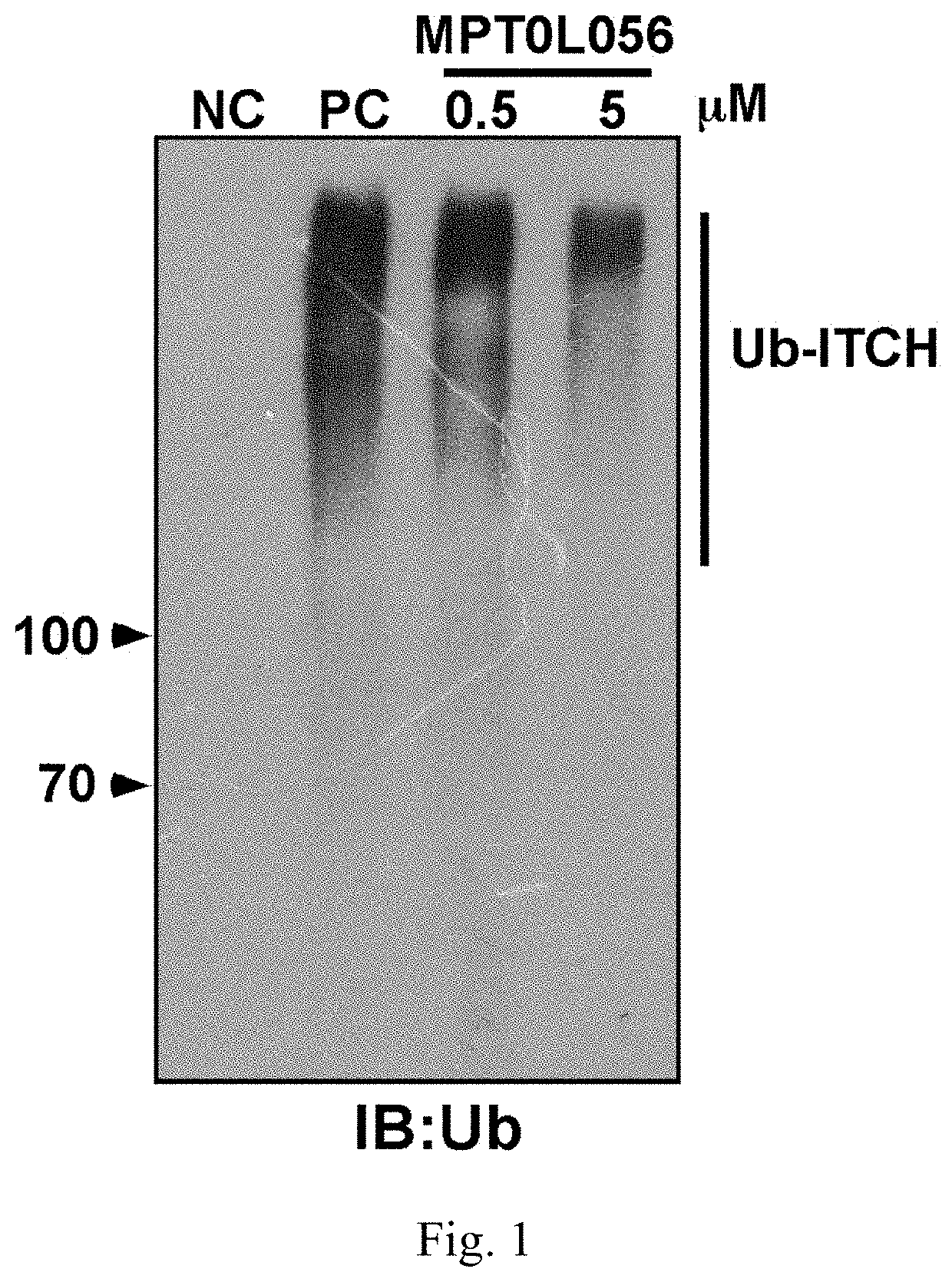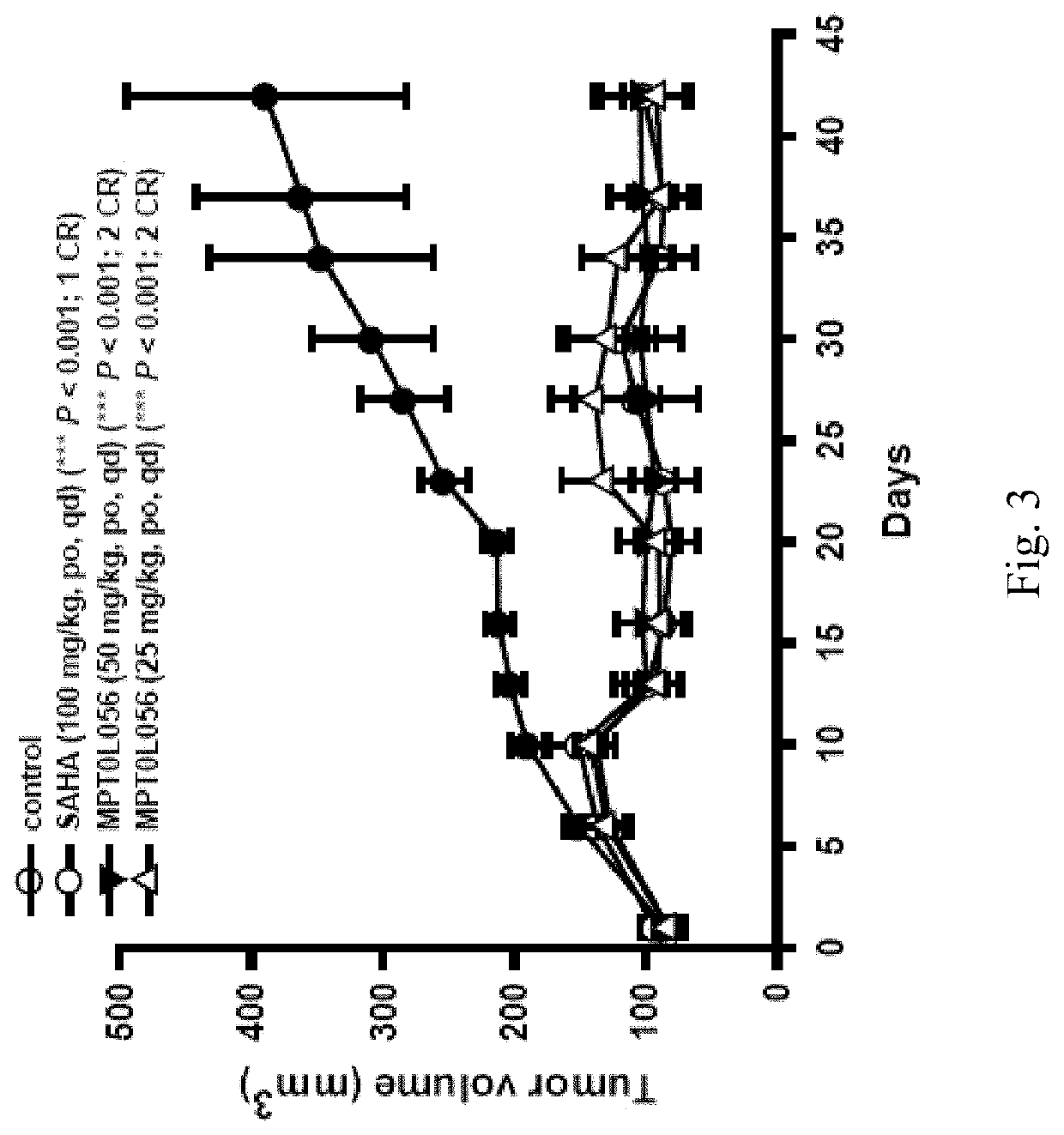Aminonapthoquinone compounds and pharmaceutical composition for blocking ubiquitination-proteasome system in diseases
a technology of ubiquitination and proteasomes, which is applied in the direction of drug compositions, immunological disorders, metabolism disorders, etc., can solve the problems of ineffective cure of cancer, significant morbidity and mortality, and severe general toxicity to the human body
- Summary
- Abstract
- Description
- Claims
- Application Information
AI Technical Summary
Benefits of technology
Problems solved by technology
Method used
Image
Examples
example 1 4-(((
3-chloro-1,4-dioxo-1,4-dihydronaphthalen-2-yl)amino)methyl)benzoic Acid (97)
[0140]
[0141]A mixture of 2,3-dichloro-1,4-naphthaquinone (0.49 g, 2.18 mmol), 4-aminomethylbenzoic acid (0.30 g, 1.98 mmol) and TEA (1 ml) was dissolved in EtOH (10 ml) and stirred and refluxed overnight. The residue was filtered by suction filtration to yield a red product. The residue was filtered without further purification to afford 97 (0.36 g, 53.20%) as a red solid. 1H-NMR (500 MHz, DMSO-d6): δ 5.01 (d, J=7.0 Hz, 2H), 7.39 (d, J=8.5 Hz, 2H), 7.75 (m, 1H), 7.81 (m, 1H), 7.88 (d, J=8.0 Hz, 2H), 7.96 (d, J=7.5 Hz, 2H), 8.05 (t, J=6.5 Hz, 1H).
example 2 4-(((
3-chloro-1,4-dioxo-1,4-dihydronaphthalen-2-yl)amino)methyl)-N-hydroxybenzamide (1)
[0142]
[0143]A mixture of 97 (0.36 g, 1.05 mmol), EDC.HCl (0.30 g, 1.58 mmol), HOBt (0.17 g, 1.26 mmol), NMM (0.28 ml, 2.52 mmol) and DMF (2.5 ml) was stirred for a while, to which was then added the o-(tetrahydro-2H-pyran-2-yl)hydroxylamine (0.15 g, 1.26 mmol) at room temperature, and the mixture was stirred overnight. The residue was purified by flash column over silica gel (ethyl acetate: n-hexane=2:1, Rf=0.45) to obtain the oily product. The oily product was then dissolved in MeOH (3 ml) and 10% TFA (aq.) (3 ml) added at room temperature and the mixture was stirred overnight. H2O was added to the reaction to produce the precipitant. The residue was filtered without further purification to afford 1 (0.24 g, 98.93%) as a red solid. 1H-NMR (500 MHz, DMSO-d6): δ 4.98 (s, 2H), 7.35 (d, J=8.5 Hz, 2H), 7.68 (d, J=8.5 Hz, 2H), 7.73 (m, 1H), 7.81 (m, 1H), 7.96 (m, 2H), 8.03 (s, 1H).
example 3 4-(((
3-chloro-1,4-dioxo-1,4-dihydronaphthalen-2-yl)amino)methyl)-N-(pyridin-2-yl)benzamide (2)
[0144]
[0145]A mixture of 97 (0.25 g, 0.73 mmol), EDC.HCl (0.21 g, 1.10 mmol), HOBt (0.12 g, 0.88 mmol), NMM (0.19 ml, 1.75 mmol) and DMF (2.0 ml) was stirred for a while, to which was then added 2-aminopyridine (0.08 g, 0.88 mmol) at room temperature and the mixture was stirred overnight. The residue was purified by flash column over silica gel (dichloromethane:methanol=30:1, Rf=0.50) to afford 2 (0.04 g, 13.11%) as a red solid. 1H-NMR (300 MHz, CDCl3): δ 5.15 (d, J=6.6 Hz, 2H), 6.33 (s, 1H), 7.08-7.12 (m, 1H), 7.49 (d, J=8.4 Hz, 2H), 7.67 (m, 1H), 7.77 (m, 2H), 7.97 (d, J=8.4 Hz, 2H), 8.08 (m, 1H), 8.18 (m, 1H), 8.33 (m, 1H), 8.40 (d, J=8.4 Hz, 1H), 8.59 (br, 1H).
PUM
| Property | Measurement | Unit |
|---|---|---|
| body weight | aaaaa | aaaaa |
| volume | aaaaa | aaaaa |
| volume | aaaaa | aaaaa |
Abstract
Description
Claims
Application Information
 Login to View More
Login to View More - R&D
- Intellectual Property
- Life Sciences
- Materials
- Tech Scout
- Unparalleled Data Quality
- Higher Quality Content
- 60% Fewer Hallucinations
Browse by: Latest US Patents, China's latest patents, Technical Efficacy Thesaurus, Application Domain, Technology Topic, Popular Technical Reports.
© 2025 PatSnap. All rights reserved.Legal|Privacy policy|Modern Slavery Act Transparency Statement|Sitemap|About US| Contact US: help@patsnap.com



